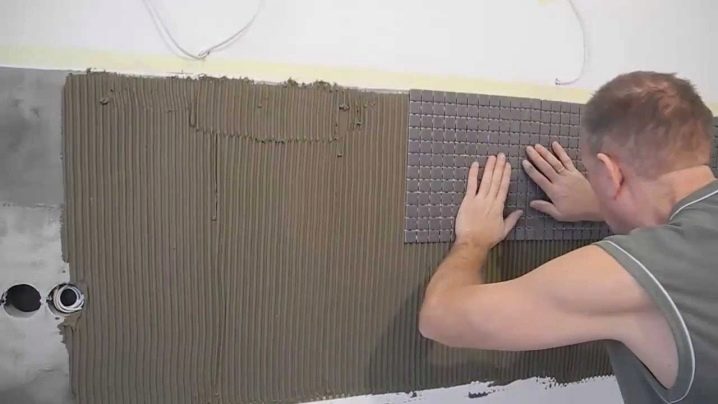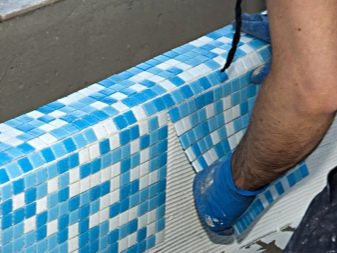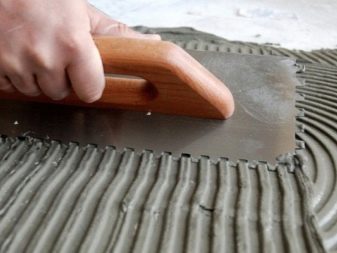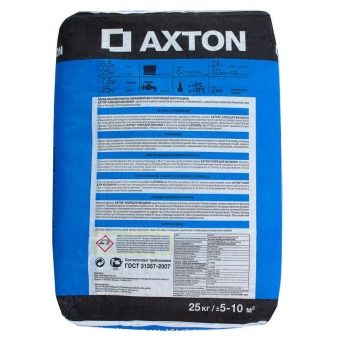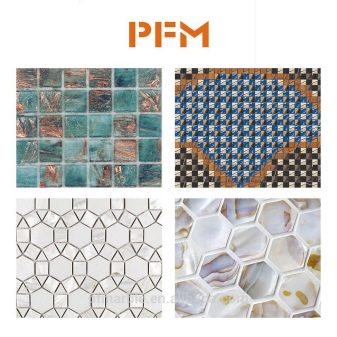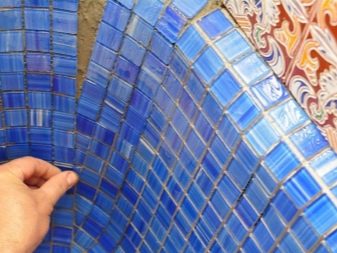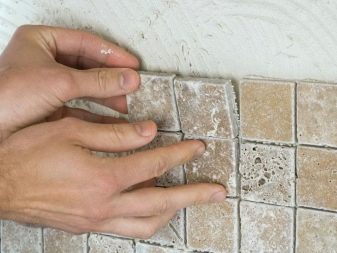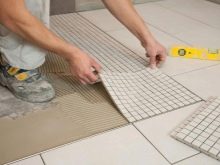Mosaic glue: variations and selection criteria
Oriental-style interiors are gaining popularity not only in residential buildings, but also in public places. Mosaic walls look incredibly beautiful and give the room a rich look. Such a design can be created both independently and seek the help of professionals. In addition to the mosaic tile, the right adhesive is of great importance. Many brands produce compounds designed specifically for this tile.
Kinds
For the majority of ordinary people, mosaic walls are associated with oriental palaces and rich pools, however, modern ideas about interior design are much broader. Today, this type of installation is used in apartment bathrooms, kitchens and living rooms. A variety of color combinations and shapes makes it possible to fantasize with the design. However, in order to serve the tile for a long time, it is necessary to choose the right glue.Modern stores offer a wide range of products, each of which has its own functionality, which determines the place of use of the mixture. Mosaic glue is represented by three types. It is worth considering each of the types in more detail.
Cement
This composition is produced in dry form with the use of white or gray cement, which affect the resulting color of the mixture. Dilute with water or latex before use.
Cement fixative composition is divided into several subspecies.
- Hard glue is used in case of lining a smooth and clean surface. It is also used when working with a brick or plastered wall, gas or foam concrete block or concrete base with grout.
- Elastic glue should be used in more difficult situations. It is perfect for outdoor work or underfloor heating.
- The highly elastic composition binds tiles well on substrates that do not absorb moisture, are subject to changes in temperature and humidity, as well as in rooms with vibration. The properties of the mixture compensate for all sorts of fluctuations.
The great advantage of this type is the affordable price.
Dispersive
This type is one-component and is sold in a ready-made form. An important advantage of this mixture is ease of use, as it does not require additional preparations. Dispersion adhesive is the best option for working in an apartment, because it does not leave behind a layer of dust. Professional masters recommend using the composition for a mini-repair, the glue is economically consumed, and the remainder does not dry out, just tightly cover the bucket with the finished mixture until it is needed again.
Dispersion composition is more expensive than cement, however, and problems with it are much less.
Reactive
The peculiarity of the two-component glue consists in a chemical reaction, in which its ingredients enter when mixed. The most common are products with a polyurethane and epoxy base. This composition is used for particularly complex work. Due to the lack of water in the composition of the reactive form will be an excellent option for natural stone and other bases that are sensitive to moisture. The mosaic mix fixes the tile even on a glass, wooden, plastic or metal surface.When applying this glue, it is better to trust the professionals, since all actions must be carried out quickly and accurately. The composition dries quickly, therefore, it is recommended to prepare it in small parts.
In case of detection of glue residue on the surface of the mosaic, you should immediately wipe it off, because after curing it will be difficult to wipe it off.
Choice: what to consider?
When buying mosaic glue, you should rely on the type of tile, the characteristics of the base to be coated and the type of room. Before buying it is recommended to determine the exact timing of work. If time is not very much, it is better to use fast-hardening composition.
Surface quality
In the presence of a smooth and clean surface, the glue will be easily applied even with a silicone spatula, and the mosaic tile will be held evenly and for a long time. On such walls, a mosaic pattern looks like a bead. Decorative elements can be laid on the plastered wall or cement screed by any glue. When facing will be made on a rough or waterproofing base, you need to use a highly elastic adhesive with polyurethane or epoxy base.
The nature of the room
It is quite simple to make laying of any tile in a warm room; another thing is when it is necessary to revet walls and floors with mosaics that will be constantly under the influence of moisture. Such places are the pool, steam bath, fountains. In this case, you should choose an adhesive composition with special characteristics. One of the main features should be the ability to absorb moisture. The second requirement is the high elasticity of the mixture, which will contribute to the stable fixing of the mosaic to the base.
In places with high humidity, the level of adhesion of the adhesive is an important selection criterion for cladding with glass tiles. The waterproof mixture should have an adhesion of at least 2.5 MPa, which will ensure optimum adhesion of the glass surface and the waterproofing base of the pool. However, the maximum strength of attachment gives mosaic adhesive composition, diluted with a liquid latex, in this case, the composition becomes a small diamond shine. It should be remembered that after laying the tiles inside the pool, it will be possible to fill it in only two, and preferably three weeks.Such a condition is necessary for the final hardening of the adhesive and fixing the mosaic on the surface.
In the case of lining in the pool in the open air, you need to take into account the temperature of the air, which should be above +5 degrees.
The composition of the adhesive and the type of mosaic
There are several types of mosaics, each of which is also recommended a special adhesive composition. Some species are suitable already ready mixture, others - cement, which must be mixed with water. White and gray are the most popular, one of which is designed for glass, or as it is also called mirror mosaic, the other - for more homogeneous.
Glass and stone
A mosaic of glass is more whimsical in choosing glue than stone, since the base can be seen through the transparent tile. When the glass facing the surface using a white adhesive composition. When using adhesive with the addition of gray cement, a dark color will be visible under the tile and may distort the final result. For cladding ceramics, you can choose any fixing composition, regardless of color, as a dense tile will cover any traces of black work.In this case, it is recommended to focus on the nature of the base. When working with natural stone, you need to focus on the type of material and its features, as not every stone can withstand the effects of even a small amount of moisture.
In this case, it is better to purchase a reactive mixture with a minimum freezing time.
On the grid
To simplify the process of facing the surface with mosaic tiles, many brands produce adhesive mosaic tiles, which significantly reduces the time of work and is easy to use. If the work uses a tile with a net or paper base, there is no longer any need to spend time on each part separately. Mosaic on the grid allows you to revet the walls and the floor at once in blocks, rather than small squares. In this case, the adhesive is selected according to the type of surface to be veneered. The only thing that should be done in advance is to mark the basis for a uniform and beautiful pattern. It is important to adjust the immersion of the mesh on the back side of the block in the adhesive mixture; it should be uniformly covered with a solution. The paper plays the role of a connecting material and is glued in front of the unit.At the end of laying, the mosaic tile is moistened with a sponge or cloth, after which wet paper should be carefully removed.
Stamps
A huge number of brands offer glue for mosaic tiles.
Among them are the two most popular companies.
- Litokol K55 is a dry white cement composition that should be diluted with water before use. Its characteristics allow both external and internal operation not only of mosaics, but also of ceramics and natural stone. This fixative composition has a high level of frost and water resistance, is elastic and environmentally friendly, it does not emit a toxic odor that is dangerous to health. The adhesive is designed for laying mosaics in swimming pools, bathrooms and in the kitchen. Before lining the surface should be cleaned and it is desirable to level with plaster to ensure better adhesion of the base and tile.
- Lacrysil product - it is ready to use acrylic glue. The water-dispersion composition is suitable for work with any type of mosaic, as well as with ceramic tiles and natural stone. The mixture is environmentally friendly and safe for health.Lacrysil mosaic glue is vibration-proof, therefore it is suitable for rooms located near the railway. The elastic composition is able to withstand a high load, it can be used for lining a heated floor.
Mosaic glue is a necessary component for creating a beautiful oriental pattern. The final result depends on the correct choice of mix, so during the purchase you should take into account all the above factors for a successful repair.
How to glue the mosaic, see the next video.

